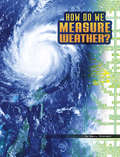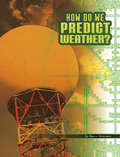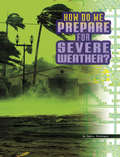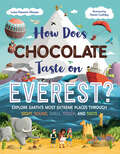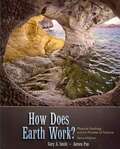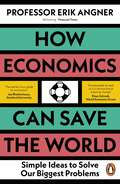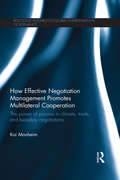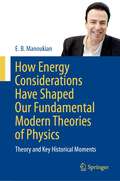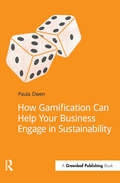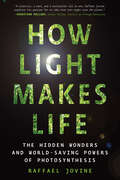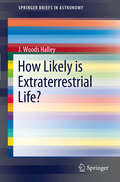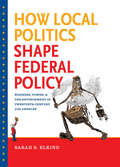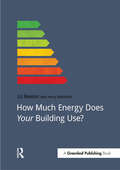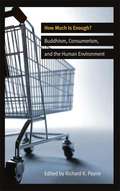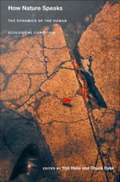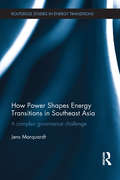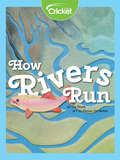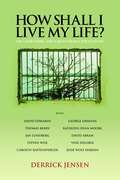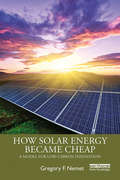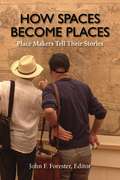- Table View
- List View
How Do We Measure Weather? (Discover Meteorology)
by Nancy DickmannHow fast is the wind blowing? How much moisture is in the air? Meteorologists measure weather conditions to help answer these and other questions. Learn about the tools and systems they use. Find out how these measurements help people plan their days and prepare for any weather.
How Do We Predict Weather? (Discover Meteorology)
by Nancy DickmannWill tomorrow be cold or warm? Cloudy or sunny? Wet or dry? Meteorologists make predictions about how weather conditions will change. Find out how they do it and what challenges they face in trying to help people prepare for coming weather conditions.
How Do We Prepare for Severe Weather? (Discover Meteorology)
by Nancy DickmannA storm is coming! How do people prepare? What supplies and tools do we need to survive? Find out how people prepare for all kinds of severe weather. From tornadoes to hurricanes and blizzards to floods, we can be ready for anything.
How Does Chocolate Taste on Everest?: Explore Earth's Most Extreme Places Through Sight, Sound, Smell, Touch and Taste
by Leisa Stewart-SharpeDon't get too comfortable. This isn't the type of book you can snuggle up with under the covers. Not even close! You're off on the expedition of a lifetime to experience the sights, sounds, smells, feelings and tastes of the world's most extreme places. Have you ever wondered what the buzz of the rainforest sounds like on a trek through the Amazon? Or how it would feel to experience the biting cold as you voyage across Antarctica? Or how about how chocolate would taste on Mount Everest? From every heart-bursting sight to tummy-lurching bite, this is a truly immersive round-the-world adventure, where YOU are the explorer.
How Does Chocolate Taste on Everest?: Explore Earth's Most Extreme Places Through Sight, Sound, Smell, Touch, and Taste
by Leisa Stewart-SharpeAn immersive round-the-world adventure, where YOU are the explorer experiencing the most extreme places on earth and doing it all through your five senses.Have you ever wondered what the buzz of the rain forest sounds like on a trek through the Amazon? Or how it feels to experience the biting cold as you voyage across Antarctica? Or how chocolate tastes on Mount Everest? From every heart-bursting sight to tummy-lurching smell, you will experience them all–and do so without having to leave the comforts of your couch.This funny and fast-paced interactive thrill ride that young adventure-seekers are sure to enjoy is chock-full of facts, history, and survival tips peppered on every page.
How Does Earth Work?: Physical Geology and the Process of Science
by Gary Smith Aurora PunEncouraging students to observe, discover, and visualize, How Does Earth Work? Second Edition engages students with an inquiry-based learning method that develops a solid interpretation of introductory geology. Like geology detectives, students learn to think through the scientific process and uncover evidence that explains earth’s mysteries.
How Economics Can Save the World: Simple Ideas to Solve Our Biggest Problems
by Erik AngnerEconomics has the power to make the world a better, happier and safer place: this book shows you howOur world is in a mess. The challenges of climate change, inequality, hunger and a global pandemic mean our way of life seems more imperilled and society more divided than ever; but economics can help!From parenting to organ donation, housing to anti-social behaviour, economics provides the tools we need to fix the biggest issues of today. Far from being a means to predict the stock market or enrich the elite, economics provides a lens through which we can better understand how things work, design clever solutions and create the conditions in which we can all flourish.With a healthy dose of optimism, and packed with stories of economics in everyday situations, Erik Angner demonstrates the methods he and his fellow economists use to help improve our lives and the society in which we live. He shows us that economics can be a powerful force for good, awakening the possibility of a happier, more just and more sustainable world.
How Effective Negotiation Management Promotes Multilateral Cooperation: The power of process in climate, trade, and biosafety negotiations (Routledge Research in Global Environmental Governance)
by Kai MonheimMultilateral negotiations on worldwide challenges have grown in importance with rising global interdependence. Yet, they have recently proven slow to address these challenges successfully. This book discusses the questions which have arisen from the highly varying results of recent multilateral attempts to reach cooperation on some of the critical global challenges of our times. These include the long-awaited UN climate change summit in Copenhagen, which ended without official agreement in 2009; Cancún one year later, attaining at least moderate tangible results; the first salient trade negotiations after the creation of the WTO, which broke down in Seattle in 1999 and were only successfully launched in 2001 in Qatar as the Doha Development Agenda; and the biosafety negotiations to address the international handling of Living Modified Organisms, which first collapsed in 1999, before they reached the Cartagena Protocol in 2000. Using in-depth empirical analysis, the book examines the determinants of success or failure in efforts to form regimes and manage the process of multilateral negotiations. The book draws on data from 62 interviews with organizers and chief climate and trade negotiators to discover what has driven delegations in their final decision on agreement, finding that with negotiation management, organisers hold a powerful tool in their hands to influence multilateral negotiations. This comprehensive negotiation framework, its comparison across regimes and the rich and first-hand empirical material from decision-makers make this invaluable reading for students and scholars of politics, international relations, global environmental governance, climate change and international trade, as well as organizers and delegates of multilateral negotiations. This research has been awarded the German Mediation Scholarship Prize for 2014 by the Center for Mediation in Cologne.
How Energy Considerations Have Shaped Our Fundamental Modern Theories of Physics: Theory and Key Historical Moments
by E. B. ManoukianAt long last, with sufficient technical details, emphasizing key historical moments, a book that develops all of fundamental modern theoretical physics from energy considerations in a compact form. Starting with a few electron-volts of atoms in the quantum world at low energies extending up to quantum gravity and beyond to the birth of the Universe, readers will experience the entire spectrum of fundamental modern theoretical physics, with one theory leading to another in an integrated unified manner. Energy considerations lead to the development of special and general relativity, quantum field theory, renormalization theory, modern quantum electrodynamics, electro-weak theory, the standard model of particle physics, grand unified theories, string theory, the current standard model of inflationary big bang theory, and even to the birth of the Higgs field, and in developments of quantum gravity. Unfortunately, due to strong specialization within theirfields, students and many practicing physicists are exposed only to parts of the beautiful story of modern fundamental physics. Here the entire story is told! This is a must-read book for graduate students, advanced undergraduate students, instructors and professionals who are interested in all aspects of fundamental modern theoretical physics and key historical moments in its development.
How Gamification Can Help Your Business Engage in Sustainability
by Paula OwenVirtually unknown just a few years ago, gamification is fast emerging as a user engagement and behaviour change tool that succeeds where other tactics and strategies have failed. It's the new "business tech trend to watch", and is already being tested in a diverse range of sectors.Not only useful for strengthening communication and engagement and as a potent behaviour change agent, it is also being advocated as a uniquely effective tool for stimulating innovative thinking and new ideas. In the environmental sector, "eco-gamification" is showing early promise in sustainable transport, employee engagement, energy and recycling, and its potential for other sectors is clear.This book contains all the information businesses and other organizations need to make an informed decision about whether to adopt gamification as part of their own business and sustainability strategies – and the tools to get started. Owen's expert investigation outlines the latest theory, tactics and strategies, draws together emerging best practice and points to stand-out successes in the health and fitness, medical research, and financial sectors, as well as early successes in "eco-gamification".Whether the people you are engaging are customers, citizens, employees, shareholders, executives or board members, if you're an organization concerned with enhancing environmental sustainability, and you want your efforts to make a real and lasting difference, this book is for you.
How Light Makes Life: The Hidden Wonders And World-saving Powers Of Photosynthesis
by Raffael JovineA revelatory journey of discovery into the intricate, beautiful, and often surprising processes that convert energy from the sun into life, and how all-important these are to our survival—and our planet’s future It’s a clunky word for a miracle: Photosynthesis. But there’s no life on Earth without it. For biologist Raffael Jovine, it’s a consuming passion, a great unsung force of nature. He makes his case in How Light Makes Life, a catalog of living wonders—and a blueprint for a better planet. Imagine harvesting pure sunlight to use as fuel, while turning carbon dioxide into breathable oxygen. This is what a leaf does every day. And photosynthesis isn’t just for plants: Corals partner with photosynthetic organisms to create the most productive habitat on Earth. Slugs eat chloroplasts as natural green camouflage. Hornets use photosynthesis as an innovative means of air-conditioning—and much more! The revelatory vision of How Light Makes Life is how we ourselves might harness the power of photosynthesis: to repair ecosystems, stabilize the climate, and grow more food sustainably. On this vivid journey, you’ll see how every seed contains the key to our future—through the photosynthetic pigments in your own eyes!
How Likely is Extraterrestrial Life?
by J. Woods HalleyWhat does existing scientific knowledge about physics, chemistry, meteorology and biology tell us about the likelihood of extraterrestrial life and civilizations? And what does the fact that there is currently no credible scientific evidence for the existence of extraterrestrial biospheres or civilizations teach us? This book reviews the various scientific issues that arise in considering the question of how common extraterrestrial life is likely to be in our galaxy and whether humans are likely to detect it. The book stands out because of its very systematic organization and relatively unbiased treatment of the main open question. It covers all relevant aspects of many disciplines required to present the different possible answers. It has and will provide undergraduates with a stimulating introduction to many of these fields at an early stage in their university careers, when they are still choosing a specialty. The difficulties and the range of possible answers to the title question are carefully addressed in the light of present understanding. The resulting perspective is distinctly different from those suggested by most other books on this topic.
How Local Politics Shape Federal Policy
by Sarah S. ElkindFocusing on five Los Angeles environmental policy debates between 1920 and 1950, Sarah Elkind investigates how practices in American municipal government gave business groups political legitimacy at the local level as well as unanticipated influence over federal politics. Los Angeles's struggles with oil drilling, air pollution, flooding, and water and power supplies expose the clout business has had over government. Revealing the huge disparities between big business groups and individual community members in power, influence, and the ability to participate in policy debates, Elkind shows that business groups secured their political power by providing Los Angeles authorities with much-needed services, including studying emerging problems and framing public debates. As a result, government officials came to view business interests as the public interest. When federal agencies looked to local powerbrokers for project ideas and political support, local business interests influenced federal policy, too. Los Angeles, with its many environmental problems and its dependence upon the federal government, provides a distillation of national urban trends, Elkind argues, and is thus an ideal jumping-off point for understanding environmental politics and the power of business in the middle of the twentieth century.
How Mountains Are Made
by Kathleen Weidner Zoehfeld James Graham HaleEven though Mount Everest measures 29,028 feet high, it may be growing about two inches a year. A mountain might be thousands of feet high, but it can still grow taller or shorter each year. Mountains are created when the huge plates that make up the earth's outer shell very slowly pull and push against one another. Read and find out about all the different kinds of mountains.
How Mountains Are Made (Let's-Read-and-Find-Out Science 2)
by Kathleen Weidner ZoehfeldRead and find out about how mountains are made in this colorfully illustrated nonfiction picture book.A mountain might be thousands of feet high, but it can still grow taller or shorter each year. This classic picture book explores how mountains are made—including how Mount Everest grew from a flat plain under an ocean to become 29,028 feet tall.How Mountains Are Made features simple activities and fascinating cross-sections of the earth’s moving crust that clearly explain plate tectonics. Both text and artwork were vetted for accuracy by an expert in the field.This is a clear and appealing science book for early elementary age kids, both at home and in the classroom. It's a Level 2 Let's-Read-and-Find-Out, which means the book explores more challenging concepts for children in the primary grades. The 100+ titles in this leading nonfiction series are:hands-on and visualacclaimed and trustedgreat for classroomsTop 10 reasons to love LRFOs:Entertain and educate at the same timeHave appealing, child-centered topicsDevelopmentally appropriate for emerging readersFocused; answering questions instead of using survey approachEmploy engaging picture book quality illustrationsUse simple charts and graphics to improve visual literacy skillsFeature hands-on activities to engage young scientistsMeet national science education standardsWritten/illustrated by award-winning authors/illustrators & vetted by an expert in the fieldOver 130 titles in print, meeting a wide range of kids' scientific interestsBooks in this series support the Common Core Learning Standards, Next Generation Science Standards, and the Science, Technology, Engineering, and Math (STEM) standards. Let's-Read-and-Find-Out is the winner of the American Association for the Advancement of Science/Subaru Science Books & Films Prize for Outstanding Science Series.
How Much Energy Does Your Building Use? (Doshorts Ser.)
by Kerry Mashford Liz ReasonWhy do award-winning "green" buildings so often have higher energy bills than ordinary buildings? Why do expensive refurbishments deliver outcomes that are far from the promises of improved sustainability? Why does your building have high running costs and still the occupants complain about being too cold or too hot and are otherwise dissatisfied?The failure of many countries to produce buildings that are comfortable with excellent energy performance is a scandal. Achieving low energy buildings does not involve learning rocket science: just some basic building physics, a clear language for talking meaningfully about energy-efficient outcomes with all those in the buildings cycle, and an outlook that casts a new low energy perspective on old problems. This book provides that common language. It outlines a path towards understanding what makes for a good quality low energy building, the stakeholders that need to be engaged, and encourages new ways of thinking about how to reduce energy use and costs.This book is for everyone in the buildings cycle, from CEOs of major construction companies to Sustainability, Energy, Environment, Facilities and Utilities managers in any company that aims to reduce energy use in a non-domestic building.
How Much is Enough?
by Richard K. PayneThe massive outpouring of consumer products available today might alone lead one to ask "How much is enough?" But at the same time, if we allow ourselves to see the social, political, economic and environmental consequences of the system that produces such a mass of "goods," then the question is not simply a matter of one's own personal choice, but points to the profound interconnectedness of our day to day decisions about "How much is enough?" The ease with which we can acquire massive quantities of food, clothing, kitchenware, and various electronic goods directly connects each of us with not only environmental degradation caused by strip mining in West Virginia, and with sweat shops and child labor in India or Africa, but also with the ongoing financial volatility of Western capitalist economies, and the increasing discrepancies of wealth in all countries. This interconnectedness is the human environment, a phrase intended to point toward the deep interconnection between the immediacy of our own lives, including the question of "How much is enough?," and both the social and natural worlds around us. This collection brings together essays from an international conference jointly sponsored by Ryukoku University, Kyoto, and the Institute of Buddhist Studies, Berkeley. The effects of our own decisions and actions on the human environment is examined from several different perspectives, all informed by Buddhist thought. The contributors are all simultaneously Buddhist scholars, practitioners, and activists - thus the collection is not simply a conversation between these differing perspectives, but rather demonstrates the integral unity of theory and practice for Buddhism.
How Nature Speaks: The Dynamics of the Human Ecological Condition
by Yrjö Haila Chuck DykeHow Nature Speaks illustrates the convergence of complexity theory in the biophysical and social sciences and the implications of the science of complexity for environmental politics and practice. This collection of essays focuses on uncertainty, surprise, and positionality--situated rather than absolute knowledge--in studies of nature by people embedded within the very thing they purport to study from the outside. The contributors address the complicated relationship between scientists and nature as part of a broader reassessment of how we conceive of ourselves, knowledge, and the world that we both inhabit and shape. Exploring ways of conceiving the complexity and multiplicity of humans' many interactive relationships with the environment, the contributors provide in-depth case studies of the interweaving of culture and nature in socio-historical processes. The case studies focus on the origin of environmental movements, the politicization of environmental issues in city politics, the development of a local energy production system, and the convergence of forest management practices toward a dominant scheme. They are supported by explorations of big-picture issues: recurring themes in studies of social and environmental dynamics, the difficulties of deliberative democracy, and the potential gains for socio-ecological research offered by developmental systems theory and Pierre Bourdieu's theory of intentionality. How Nature Speaks includes a helpful primer, "On Thinking Dynamically about the Human Ecological Condition," which explains the basic principles of complexity and nonlinear thinking. Contributors. Chuck Dyke, Yrj Haila, Ari Jokinen, Ville Lhde, Markus Laine, Iordanis Marcoulatos, John O'Neill, Susan Oyama, Taru Peltola, Lasse Peltonen, John Shotter, Peter Taylor
How Power Shapes Energy Transitions in Southeast Asia: A complex governance challenge (Routledge Studies in Energy Transitions)
by Jens MarquardtAn understanding of the role of energy-related governance systems and the conditions required for a shift towards renewables in developing countries is urgently needed in order to tap into the global potential of low-carbon development. Although renewable energy sources have become technically feasible and economically viable, social and political factors continue to persist as the most critical obstacles for their dissemination. How Power Shapes Energy Transitions in Southeast Asia conceptualizes power for the field of sustainable energy governance. Based on empirical findings from the Philippines and Indonesia, the book develops an analytical approach that incorporates power theory into a multi-level governance framework. The book begins with a profound background on renewable energy development around the world and presents major trends in development cooperation. A power-based multi-level governance approach is introduced that is rooted in development thinking. Examining how coordination and power relations shape the development and dissemination of renewable energy technologies, the book also shows how decentralization affects low carbon development in emerging economies. Sparking debate on the ways in which energy transitions can be triggered and sustained in developing countries, this book will be of great interest to students and scholars of renewable energy development and environmental politics and governance as well as practitioners in development cooperation.
How Rivers Run
by Liz HuyckHave you ever wondered how a river forms, which animals live near rivers, or where those rivers lead? Rivers are a vital part of life and the ecosystem. Rivers help transport water to humans and animals as well. It can also be used to create energy. Water from rivers can end up in many different places downstream!
How Shall I Live My Life? On Liberating the Earth from Civilization
by Derrick JensenInterviews with Vine Deloria, Jesse Wolf Hardin, David Abram, Kathleen Dean Moore, Carolyn Raffensperger, George Draffan, Steven Wise, Jan Lundberg, Thomas Berry, David Edwards. In this collection of interviews, Derrick Jensen discusses the destructive dominant culture with ten people who have devoted their lives to undermining it. Whether it is Carolyn Raffensperger and her radical approach to public health, or Thomas Berry on perceiving the sacred; be it Kathleen Dean Moore reminding us that our bodies are made of mountains, rivers, and sunlight; or Vine Deloria asserting that our dreams tell us more about the world than science ever can, the activists and philosophers interviewed in How Shall I Live My Life? each bravely present a few of the endless forms that resistance can and must take. Hailed as the philosopher poet of the ecological movement, Derrick Jensen is the widely acclaimed author of Endgame, A Language Older Than Words, The Culture of Make Believe (a finalist for the 2003 J. Anthony Lukas Book Prize), and Walking on Water, among many others. Jensen's writing has been described as "breaking and mending the reader's heart" (Publishers Weekly). Author, teacher, activist, and leading voice of uncompromising dissent, he regularly stirs auditoriums across the country with revolutionary spirit. He lives in Crescent City, California.
How Solar Energy Became Cheap: A Model for Low-Carbon Innovation
by Gregory F. NemetSolar energy is a substantial global industry, one that has generated trade disputes among superpowers, threatened the solvency of large energy companies, and prompted serious reconsideration of electric utility regulation rooted in the 1930s. One of the biggest payoffs from solar’s success is not the clean inexpensive electricity it can produce, but the lessons it provides for innovation in other technologies needed to address climate change. Despite the large literature on solar, including analyses of increasingly detailed datasets, the question as to how solar became inexpensive and why it took so long still remains unanswered. Drawing on developments in the US, Japan, Germany, Australia, and China, this book provides a truly comprehensive and international explanation for how solar has become inexpensive. Understanding the reasons for solar’s success enables us to take full advantage of solar’s potential. It can also teach us how to support other low-carbon technologies with analogous properties, including small modular nuclear reactors and direct air capture. However, the urgency of addressing climate change means that a key challenge in applying the solar model is in finding ways to speed up innovation. Offering suggestions and policy recommendations for accelerated innovation is another key contribution of this book. This book will be of great interest to students and scholars of energy technology and innovation, climate change and energy analysis and policy, as well as practitioners and policymakers working in the existing and emerging energy industries.
How Spaces Become Places: Place Makers Tell Their Stories
by John F. ForesterUseful and inspiring cases illustrate participatory placemaking practices and strategies.How Spaces Become Places tells stories of place makers who respond to daunting challenges of affordable housing, racial violence, and immigration, as well as community building, arts development, safe streets, and coalition-building. The book's thirteen contributors share their personal experiences tackling complex and contentious situations in cities ranging from Brooklyn to Los Angeles and from Paris to Detroit. These activists and architects, artists and planners, mediators and gardeners transform ordinary spaces into extraordinary places.These place makers recount working alongside initially suspicious residents to reclaim and enrich the communities in which they live. Readers will learn how place makers listen and learn, diagnose local problems, convene stakeholders, build trust, and invent solutions together. They will find instructive examples of work they can do within their own communities. In the aftermath of the pandemic and the murder of George Floyd, the editor argues, these accessible practice stories are more important than ever.
How To Break Up With Fast Fashion: A guilt-free guide to changing the way you shop – for good
by Lauren Bravo'A funny, achievable guide' Observer'Lauren Bravo is one of my favourite writers' Dolly Alderton'Bravo will inspire you to repair, recycle and give old items a new lease of life' StylistYou probably know the statistics: global clothing production has roughly doubled in just 15 years, and every year an estimated 300,000 tonnes of used clothing ends up in UK landfill.Fast fashion is the ultimate toxic relationship. It's bad news for the planet, our brains and our bank balances. We can't go on like this; our shopping habits need an overhaul.Journalist Lauren Bravo loves clothes more than anything, but she's called time on her affair with fast fashion in search of a slower, saner way of dressing. In this book, she'll help you do the same.How To Break Up With Fast Fashion will help you to change your mindset, fall back in love with your wardrobe and embrace more sustainable ways of shopping - from the clothes swap to the charity shop. Full of refreshing honesty and realistic advice, Lauren will inspire you to repair, recycle and give your unloved items a new lease of life without sacrificing your style.Because fashion belongs to everyone, but no outfit should cost us the earth.
How To Break Up With Fast Fashion: A guilt-free guide to changing the way you shop – for good
by Lauren Bravo'A funny, achievable guide' Observer'Lauren Bravo is one of my favourite writers' Dolly Alderton'Bravo will inspire you to repair, recycle and give old items a new lease of life' StylistYou probably know the statistics: global clothing production has roughly doubled in just 15 years, and every year an estimated 300,000 tonnes of used clothing ends up in UK landfill.Fast fashion is the ultimate toxic relationship. It's bad news for the planet, our brains and our bank balances. We can't go on like this; our shopping habits need an overhaul.Journalist Lauren Bravo loves clothes more than anything, but she's called time on her affair with fast fashion in search of a slower, saner way of dressing. In this book, she'll help you do the same.How To Break Up With Fast Fashion will help you to change your mindset, fall back in love with your wardrobe and embrace more sustainable ways of shopping - from the clothes swap to the charity shop. Full of refreshing honesty and realistic advice, Lauren will inspire you to repair, recycle and give your unloved items a new lease of life without sacrificing your style.Because fashion belongs to everyone, but no outfit should cost us the earth.
